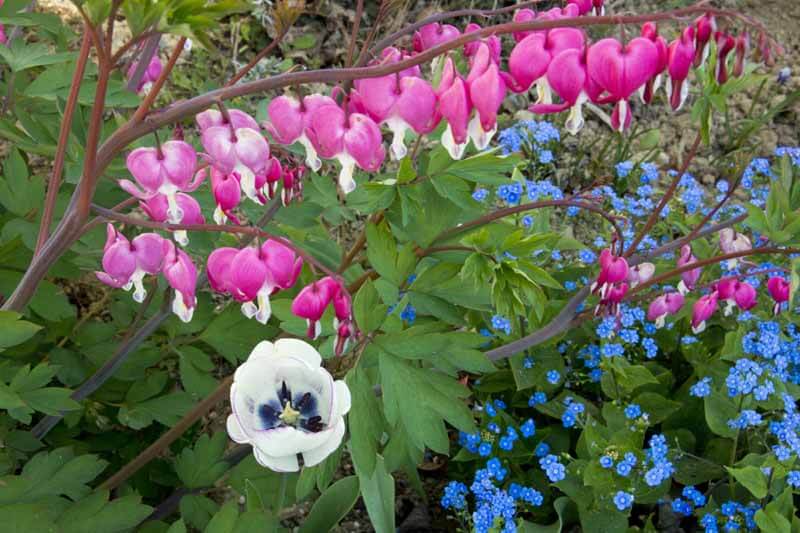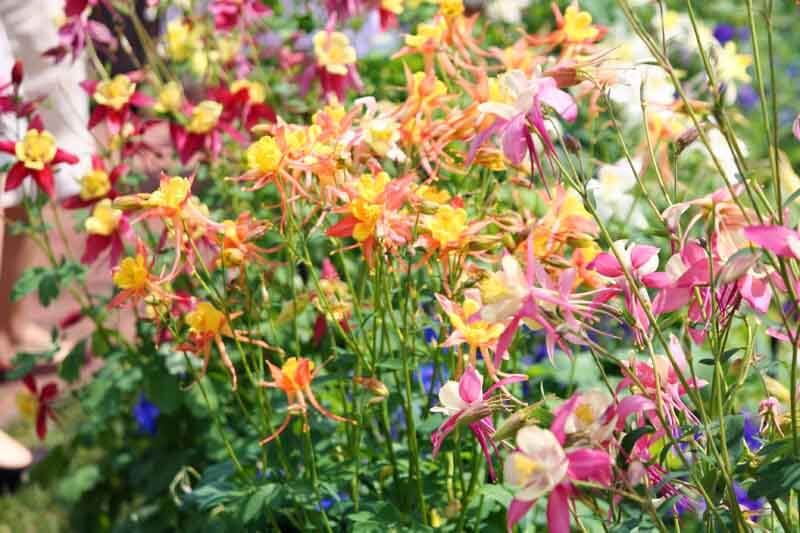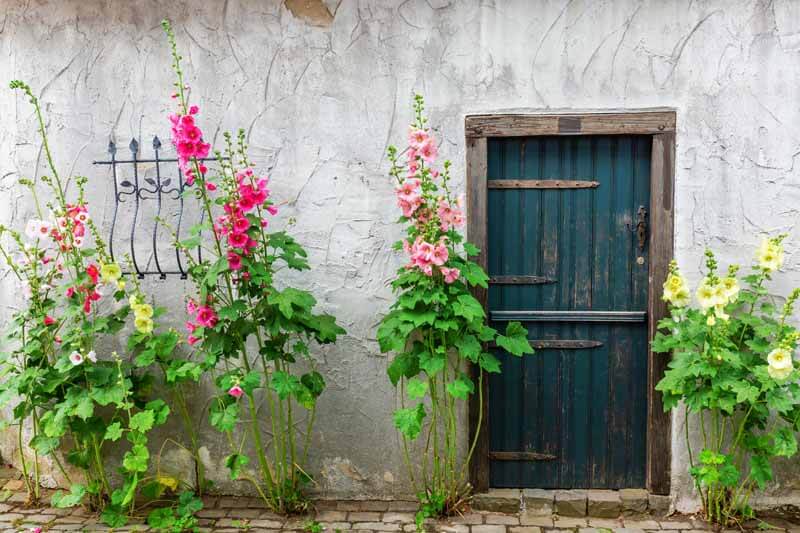
I am a person who looks at all the new perennials available in local nurseries each spring and always find new ones I cannot live without. When I get home, I look for a spot in my already full flowerbeds and stick my new purchases in. With intention, my carefree, fragrant, flower-filled garden resembles the cottage gardens of Old England. I plant as I wish.
Cottage Garden Origins

Aristocrats who had large country estates needed peasants to bring in the crops and maintain the huge gardens surrounding the mansion. The peasants lived in small cottages on the lord’s property, with stone walls and thatched roofs. The area behind the cottages was solely for vegetables, berries, and fruit-bearing trees, but the front of the cottage was devoted to flowers and herbs planted anywhere there was a space.
A picket fence with a gate ran along the front, and narrow paths wound through the flowerbeds. Most of the flowers and herbs are still used today, with many fancy new varieties available. I have many of them in my garden. Let me share a few that are as tough as nails and will not disappoint you.
Spring Cottage Garden Plants

Meadow or summer snowflake (Leucojum aestivum, USDA Hardiness Zones 4-8) can reach up to 2 feet tall and has pendulous, bell-shaped white flowers with spots of green–somewhat like a snowdrop. Unlike snowdrops, meadow snowflake blooms in early to mid-summer, and the flowers last for weeks. They grow best in full to partial sun and moist soils with good drainage. The bulbs are planted in the fall.
Bleeding Heart (Dicentra spectabilis, Zones 3-9) blooms in early May here in Indiana with dark pink, heart-shaped pendulous flowers that hang along each arching stem. They are loved by bees and hummingbirds, are deer resistant, and reach 2 to 3 feet tall. Plant them in full to partial shade in a spot with fertile soil. As the summer gets hot and dry, bleeding heart will die back and not come up again until the following spring.

Columbine (Aquilegia species and hybrids, Zones 3-8) is a spring delight. The tall, graceful stems have shooting-star blooms that come in practically every color of the rainbow. Columbine gently spread throughout the garden, and grow best in the sun to partial shade. Another thing about columbines that I enjoy is that different varieties will cross with one another and gently self-sow. So, in time those with different colored blooms will show up each year.

Peonies (Paeonia lactiflora and hybrids, Zones 3-8) have some of the most gorgeous late-spring flowers of all. The earliest varieties available just came in pinks, reds, and whites, but now there are a huge number of colors to chose from as new hybrids appear. They may have yellow, orange, and coral flowers with single, semi-double, double petals, or be pleasingly bowl-shaped. The variable flowers are large, and plants are typically around 3 feet tall, give or take. To see the best selections visit Song Sparrow Farm and Nursery’s online store.
When you plant a peony, consider it a longterm commitment. Individual plants live for over 100 years. They grow best in full to partial sun and are quite worry-free if you plant them in well-drained soil. At planting time, amend the soil with Black Gold Canadian Sphagnum Peat Moss, cover their crowns with a couple of inches of soil (no more!), and refrain from mulching heavily around them. If allowed to get too wet or mulched too heavily they can get botrytis blight. If you see black spots on the leaves, immediately get a fungicide formulated for flowers and apply. Peonies are also deer resistant.
Summer Cottage Garden Plants

Canterbury Bells (Campanula medium, Zones 5-8) have big, billowing bells of pink, violet-blue, and white that bloom in early summer. They are biennials or short-lived perennials, which means they do not bloom the first year but will in the second and possibly the third year. Plant them in full to partial sun, and give them some space. It is not uncommon for them to reach 2 to 3 feet. The variety ‘Deep Blue’ is tall, heavy flowering, and choice.
Carnations and pinks (Dianthus hybrids) with their fringed petals and sweet fragrance of clove are quintessential cottage garden plants. Thankfully, the sun-loving flowers are still popular today with lots of new varieties to add to a flower border. Proven Winners’ Fruit Punch® Cherry Vanilla pinks look old-fashioned but bloom all season, unlike classic pinks that bloom for a much shorter time in summer. It’s cherry red and double pink flowers are just beautiful. Fruit Punch® Classic Coral is comparable but has pure coral flowers. Both form tidy mounds of grey-green foliage and reach around 1 foot high.

Catmints (Nepeta hybrids) are easy plants to grow. Blueish-purple spikes appear in early summer above scented leaves that are soft gray-green. It is not catnip, but some cats find them attractive. Catmint forms spreading clumps and makes a good ground cover when planted en masse. Old varieties bloomed primarily in early summer, but the new ‘Cat’s Meow’ (20inches x 36 inches, Zones 3-8) and ‘Cat’s Pajamas’ (14 inches x 20-inches, Zones 3-8) bloom all summer, so keep an eye out for them. Catmints like plenty of sun and need well-drained soil. They are deer resistant, and bees love them.
Hollyhocks (Althea rosea) are essential to a cottage garden. Usually planted along the house or the rear of a garden, because of their 6-foot height, they come in shades of pink, yellow, black, salmon, purple, red and white, and have single or double 4 inch flowers along the stem. If given good care, hollyhocks may last for several years. Plant them in full sun and well-drained soil, remove old blooms as they begin to fade, and water when dry, but avoid getting water on the leaves. In the fall, cut the stems to the ground. Hollyhocks like to self-sow, so you may have new plants in spring.

English roses (Rosa hybrids) of all kinds are a cottage garden must, but one cannot imagine a cottage garden without a beautiful climbing rose clambering over the front door and up the walls. Until recently, these roses only bloomed in the spring, but now David Austin Roses, an English rose company with some of the best roses in the world, has climbing roses that bloom spring to fall, in every shade, ranging up to 15 ft. tall. This year bought ‘Tess of the D’Urbervilles’, a red 6-foot climber, and I can’t wait for it to bloom. Roses require full to half-day sun, in well-drained soil, and mulch, leaving a 5-inch space around the base of the plant to avoid crown rot.
There are so many other cottage garden favorites, such as delphinium (Delphinium elatum), blood geranium (Geranium sanguineum), Christmas rose (Helleborus niger), forget-me-nots (Myosotis spp.), English Lavender (Lavandula angustifolia), and Oriental poppies (Papaver orientalis), just start with a small garden and add a few new ones each year that you just can’t live without.


